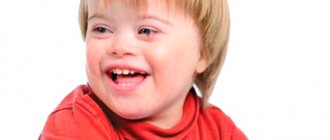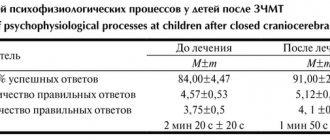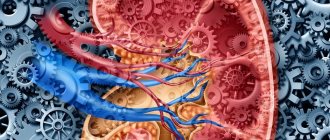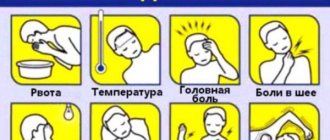Mental retardation is a congenital or acquired at an early age (up to 3 years) delay in general mental development, which is manifested by severe underdevelopment of intellectual abilities, cognitive, emotional and other areas of the psyche. Subsequently leads to social maladjustment. The term “oligophrenia” was introduced in 1915; previously there was the concept of “general mental retardation,” combining pathologies of the development of the brain and the whole organism as a whole. In ICD-10, mental retardation is described in categories F70-F79.
The disorder occurs in 0.6-3% of people, most often in a mild form, and men are most susceptible. The disorder can be caused by various etiological and pathogenetic factors affecting the period of intrauterine development, the process of childbirth or in the first years of life.
The reasons for the development of mental retardation can be: genetic predisposition, intrauterine pathologies of the fetus or prematurity, damage to the child’s central nervous system during childbirth, trauma, hypoxia, infections at an early age, pedagogical neglect. Sometimes the disorder develops due to an unknown etiology. As a rule, mental retardation does not tend to progress.
The disorder is considered to be neuropsychic. Psychomotor disorders negatively affect personal, social and professional areas of life. They typically involve difficulties in acquiring, maintaining, or using specialized skills or information. Deviations in neuropsychic development may include one or more disorders: decreased concentration, memory, perception, speech, inability to solve problems, problems with social interaction. Common psychomotor disorders include attention deficit hyperactivity disorder, autism spectrum disorder, and learning disabilities.
It is important to carry out mental and social rehabilitation of children with this disorder. If the form of mental retardation is mild or moderate, training is provided for a certain type of work; such people are able to cope with monotonous work. Training takes place in specialized boarding schools and vocational technical schools. It is imperative to carry out psychological work with the patients’ relatives to clarify all possible nuances in care and help in social adaptation.
As children grow older, they may develop depressive symptoms and self-criticism if they are socially rejected by others. Inclusive school programs contribute to social adaptation; with their help, such emotional reactions can be minimized
Causes of mental retardation
The causes of oligophrenia can be many factors associated with impaired development and maturation of the brain. In most cases, the cause of the development of the disease is a combination of external and internal factors.
Impacts that disrupt the process of embryogenesis during pregnancy have a great influence. Nervous tissue is the most sensitive to various teratogenic influences (infectious diseases of the mother, harmful addictions, irrational use of medications), as a result of which antenatal mental retardation develops. The causative agents of infectious diseases that can cause mental retardation are most often rubella, cytomegalovirus, toxoplasma, treponema, HIV, and herpes simplex virus. Prenatal infection with Zika virus results in congenital microcephaly associated with severe mental retardation. Exposure to narcotic and toxic substances on the mother's body can also cause mental retardation in the child; fetal alcohol syndrome is the most common. Use of certain anticonvulsants, chemotherapy drugs, radiation, lead, etc. Severe malnutrition during pregnancy can impair the development of the fetal brain, leading to mental retardation.
Mental retardation in the perinatal and early postnatal period develops against the background of hypoxia, neuroinfections, traumatic brain injuries, and some somatic diseases. Complications associated with prematurity, periventricular leukomalacia, breech presentation, high forceps delivery, multiple pregnancies, placenta previa, and preeclampsia may increase the risk of the disorder. A high risk is present in infants who are small for gestational age (very low or extremely low birth weight), depending on the stage of pregnancy and its progress.
External deprivation (lack of physical, emotional and cognitive support necessary for social adaptation) in early childhood is the most common cause of mental retardation. Viral and bacterial encephalitis, meningitis, poisoning with toxic substances (lead, mercury).
Research shows that genetic factors play an important role in the development of the disease, even mild cognitive impairment (inborn error of metabolism, Down syndrome, Turner syndrome, Klinefelter syndrome). Sensory stimulation deficits at an early age may also be a contributing factor.
Severe levels of the disorder can occur in any socioeconomic group. Moderate mental retardation, requiring limited support, occurs most often in lower socioeconomic groups.
The variety of factors and nonspecificity of mental retardation make it difficult to assess cause-and-effect relationships in the pathogenesis of the disorder. The true causes of the development of some forms of mental retardation have not been established (undifferentiated). Differentiated forms include forms with an established etiology and characteristic symptoms.
Classification and stages
Mental retardation is classified in different ways. The most common classification is based on the degree of intellectual disability. There are three degrees of mental retardation - debility, imbecility and idiocy. The division is based on two principles: the ability to serve oneself, the ability to learn.
In ICD-10, mental retardation is presented in categories F70-F79 and is divided by severity: mild, moderate, severe, profound.
Another clinical classification divides the disorder into asthenic, sthenic, dysphoric and atonic forms.
According to etiology and pathogenesis, mental retardation is divided into three main groups:
1. Disorders caused by hereditary pathologies. This group includes: Down syndrome, Klinefelter syndrome, Turner syndrome, Martin-Bell syndrome, true microcephaly, enzymopathic forms associated with hereditary metabolic disorders (phenylketonuria, galactosuria, etc.), hereditary neurological and neuromuscular diseases with mental retardation.
- Down syndrome. Mental retardation can be expressed in different ways, most often moderate and severe. Patients have a late appearance and pronounced underdevelopment of speech (insufficient understanding of speech, poor vocabulary, dysarthria). Children are usually unable to learn and require individual instruction. The emotional sphere is almost intact. They have a good ability to imitate, which contributes to the development of self-service skills and the performance of simple work. Over time, they do not reach a satisfactory level of social adaptation and need constant care. Children with Down syndrome are characterized by a specific physical phenotype, determined by many stigmas of dysontogenesis; diagnosis of this condition is possible immediately after birth.
- Turner syndrome (Shereshevsky-Turner). Mental retardation is defined in some sick people, usually of a mild degree. They are prone to neurotic reactions, there are worries about their condition and criticism.
- Klinefelter's syndrome. Oligophrenia occurs in a quarter of patients, mostly in a mild degree. The immaturity of the emotional-volitional sphere is expressed. Neurotic and pathocharacterological reactions are characteristic. There is often an awareness of one's inferiority, which becomes a source of internal conflict. Possible combination with depressive, hypochondriacal, obsessive, schizophrenia-like disorders.
- Phenylpyruvic mental retardation. A hereditary metabolic disorder that occurs against the background of a deficiency of one of the metabolic enzymes of the amino acid phenylalanine, which leads to a deficiency of hormones and mediators of the nervous system with further delay in mental development. Children with phenylketonuria are born with a normally formed brain. Biochemical disturbances develop immediately after birth, by 4-6 months. there is a noticeable lag in psychomotor development, and there is a tendency for the disorder to progress. Clinical manifestations include severe or profound mental retardation, behavioral disturbances and catatonic disorders, and asthenic conditions. Often increased muscle tone, convulsions, hyperkinesis, tremor of the fingers, ataxia, impaired coordination, enuresis.
2. Disorders that arose against the background of various hazards during the period of intrauterine development. Diseases caused by intrauterine infections (rubella viruses, influenza, paratitis, cytomegalovirus, pathogens of syphilis, toxoplasmosis, etc.), intoxication (for example, alcohol), hemolytic disease of the fetus, etc.
- Rubeolar embryopathy. If a woman gets rubella during pregnancy, in the first trimester of pregnancy an embryopathy with microcephaly, porencephaly, hearing and vision, and congenital malformations of internal organs is formed. Mental retardation is usually severe, and convulsions are often observed.
- Hemolytic disease of the fetus. Hemolytic disease of the fetus occurs due to Rh conflict between mother and child, which leads to hemolysis of fetal red blood cells. One of the complications of the disease may be the formation of mental retardation of varying severity.
- Alcoholic fetopathy (fetal alcohol syndrome). Mental retardation, mostly mild, delayed physical development.
3. Disorders caused by exposure to various hazards during childbirth or in the first years of life. Mental retardation associated with birth injuries, asphyxia, traumatic brain injuries, neuroinfections in early childhood.
- Neuroinfections suffered in early childhood. After meningitis and meningoencephalitis, mental retardation of varying severity, focal neurological disorders, seizures, and hydrocephalus can develop.
- Birth trauma or asphyxia during childbirth. It can lead to the formation of organic pathology of the brain and, subsequently, mental retardation with varying severity. Birth injuries are characterized by focal neurological disorders, seizures, and sometimes hydrocephalus.
With oligophrenia, there are 4 degrees of severity:
Mild degree of mental retardation (debility). It is difficult to form complex concepts and generalizations, and abstract thinking is difficult. Thinking is almost always concrete and descriptive. Everyday speech is quite developed. People suffering from mild mental retardation are able to master simple professional and work skills, as well as learn special programs based on visual learning. Satisfactory adaptation to normal living conditions is possible. Due to the faster pace of mental development, the characteristics of personality and character traits have greater individuality and differentiation, relative to other degrees of mental retardation. Such people easily adopt other people's views on life; there is difficulty in forming their own judgments.
Moderate mental retardation (mild to moderate imbecility). A person is able to form more complex ideas about what is happening around him. They can be taught simple work and self-service skills by training in imitative actions. Able to carry on a simple conversation and express oneself in simple phrases. Adaptation of such children is possible in conditions that are familiar to them. Changes in the surrounding situation can lead to difficulties due to the inability to apply the experience gained to new conditions. They need control and cannot live independently.
Severe mental retardation (severe variants of imbecility). Cognitive activity is limited to the formation of simple ideas. Patients are able to provide basic care for themselves; training is impossible. Vocabulary consists of a certain number of words. Articulation defects are present. Neurological disorders are often observed. Patients require constant monitoring and care.
Profound mental retardation (idiocy). With severe mental retardation, cognitive abilities are severely limited. Patients are almost unable to perceive speech addressed to them, do not recognize close people, do not distinguish between edible and inedible, height, size, etc. Most children suffering from idiocy cannot master the simplest self-care skills (get dressed, wash, use cutlery, etc. ). Speech is not formed or consists of several simple words. Motor function is severely underdeveloped. Behavior may vary - inactivity and lethargy, a tendency to monotonous motor agitation with stereotypy, periodic manifestations of aggressiveness, incl. auto-aggression. In most cases, severe neurological and somatic disorders are present. Patients with oligophrenia need constant care.
CHILDREN WITH INTELLECTUAL DISABILITIES
Society must be tolerant of people with mental retardation; a special approach and teachers are needed who know the specifics of the work, who can give intellectual disabilities an education and help them realize their potential.
Children with disabilities need the support of others, especially parents, who must provide such children with psychological comfort, development, and improve their quality of life.
In infants, it is quite difficult to identify mental retardation, especially its mild form, since they are almost no different from others. But their activity is impaired: they begin to hold their heads up late, babble, sit, and crawl.
But as the child grows up, when he begins to go to kindergarten, it becomes noticeable that he has difficulty maintaining a daily routine, communicating with peers, and mastering new skills. For example, a three-year-old child cannot assemble a pyramid on his own, although he repeated this many times with the teacher. My classmates succeeded after 1-2 lessons.
Oligophrenic children are not inquisitive; they cannot sit in one place for a long time, but they get tired very quickly. Their speech is poor, they confuse letters (especially consonants). Since their phonemic hearing and analysis are poorly developed, they pronounce words incorrectly, and then write incorrectly. The development of auditory discrimination and the articulatory speech apparatus lags behind - hence slurred speech.
Gross and fine motor skills suffer as the central nervous system develops abnormally. The baby's movements are uncertain and sluggish, he manipulates objects chaotically. For a long time he cannot determine the “main” hand; he moves both of them inconsistently.
Difficulties with the “pinch” and “tweezer” grip do not allow the child to hold a pencil and pen correctly and learn to write. Underdevelopment of fine motor skills also makes it difficult to care for oneself.
The child cannot concentrate and remember something. This negatively affects cognitive activity and mental activity. The baby does not see or hear what is said to him due to attention problems.
Studying is difficult for such children: they learn the material slowly because they do not remember it and cannot reproduce the information received. They cannot apply the skill or knowledge they have learned after repeated repetitions and quickly forget it.
The child is not able to express feelings verbally, because he has poor speech, but he expresses emotions through facial expressions, touches, and gestures. He is incapable of empathy. His will is weak, so he is trusting of any person, easily suggestible, and this is very dangerous.
Contact a specialist (neurologist) without delay if your child behaves unusually or you do not understand what is happening to him. The benefit of this is double - in the best case, all doubts about the adequacy of your child will be dispelled, and in the worst case (which, however, is also not bad) - early diagnosis will allow you to immediately take measures to solve the problem. This will allow such a child to be better socialized and adapted to life.
The doctor will examine the little patient, ask the parents about the symptoms, when they appeared, about the child’s practical and social skills, adaptive behavior, etc. An intelligence test is required to find out how teachable the child is, how he can solve problems and think abstractly. An IQ below 70 may indicate the presence of intellectual disability and its level.
Tips for parents
The following recommendations can be given to mothers and fathers of special children:
- Of course, hearing such a diagnosis for your child is a terrible blow, causing negative thoughts. There is a feeling of guilt, resentment at fate, anger, despair, melancholy. But you still have to accept this fact, come to terms with it, and communication with other parents who have a similar problem can be a good support. It’s also a good idea to visit a psychologist.
- You need to clearly separate your capabilities from what is impossible to do and, without giving up, look for ways to solve problems and means.
- Consult with specialists. It is also advisable to collect as much information as possible from serious sources about mental retardation, how and how you can help the child, what exactly should be done, where to go. The experience of families with an oligophrenic child is invaluable, communicate with them.
- Learn about and take advantage of government and community services for families with children with mental retardation.
- Think not about limitations, but about your child’s capabilities, what he can do and what he needs, how to please him. It is in your power to help him become independent and socialize as much as possible.
- Under no circumstances isolate your child from other people, neither children nor adults.
- Despite the fact that the level of development of your child at certain stages is lower than that of his peers, you need to communicate with him not as with a baby, but in accordance with his age.
- It is necessary to regularly conduct developmental and training sessions. The goal of education is social adaptation, that is, the child must master speech, writing, and everyday independence.
Don’t expect anything special from all your efforts, some super-result, be happy with the smallest progress. But we shouldn’t stop there either. Even if you understand your child by individual words, this is not enough for communication with others and social adaptation. Move on, don't give up and don't indulge your child's laziness.
To reduce the likelihood of having a mentally retarded child, a pregnant woman should:
- DO NOT drink, smoke or take drugs;
- take folic acid;
- visit a doctor regularly;
- Eat a diet containing fruits and vegetables, whole grains, and foods low in saturated fat.
After the baby is born:
- carry out screening of the baby - this will identify diseases that can provoke mental retardation;
- visit your pediatrician regularly;
- do all scheduled vaccinations;
- allow him to ride a bicycle only with a helmet, and to ride in a car until the required age only in a car seat;
- Avoid contact of your child with household chemicals and lead-based paints.
Support by specialists
A child with an intellectual disability needs comprehensive support throughout childhood from the following specialists:
- child psychologist and psychiatrist;
- speech therapist;
- neurologist;
- speech pathologist.
If there are other disorders (blindness, deafness, cerebral palsy, autism spectrum disorder), then a rehabilitation specialist, an ophthalmologist, a massage therapist, and a physical therapy teacher are added to the above-mentioned professionals.
Symptoms
Mental disorders in oligophrenia are polymorphic in severity and nature. Intelligence reflects the formation of a large complex of cognitive functions that are affected unevenly in this disorder (with oligophrenia, emotional-volitional processes are greatly impaired, Down syndrome - verbal functions are more negatively affected).
Common manifestations of mental retardation:
- reduced level of intelligence;
- lack of motivation in behavior;
- opinion depends entirely on others;
- are unable to understand the consequences of their actions;
- tendency to impulsive behavior;
- absent or reduced ability to learn and apply knowledge in practice;
- social maladjustment;
- increased fatigue, decreased concentration.
Forms of mental retardation, according to the characteristics of violations of the emotional-volitional sphere, are divided into:
Stenic. Volitional processes are strong and stable. People with this form of mental retardation are efficient and active. With a mild degree of intellectual disability, they are well able to adapt, make full use of knowledge and skills. Sometimes, affective instability may be noted; on this basis, a balanced and unbalanced type of sthenic form is distinguished.
Dysphoric. There is an angry-sad affect, a tendency toward dysphoria, impulsiveness, conflict, and negativism. People are not capable of learning and working. During the period of dysphoria, they are often aggressive, manifestations of auto-aggression are possible, they may not pay attention to the comments of adults, and often provoke conflicts.
Asthenic. Unstable volitional processes, fatigue, slowness, impaired concentration. Mastering and applying practical skills is difficult.
Atonic. The ability for purposeful activity is practically absent. The person is completely inactive or chaotically motorally disinhibited.
Comorbid disorders are common - attention deficit hyperactivity disorder, depressive, anxiety and bipolar affective disorder, autism spectrum disorder.
In some cases, there are comorbid motor or sensory impairments, cerebral palsy or other motor deficits, speech delay, or hearing loss. Such motor or sensory impairments do not cause cognitive impairment, but may contribute to its development.
Complications
Oligophrenia can be complicated by other mental and somatic disorders.
Mental disorders include behavioral disorders - a tendency to impulsive actions, aggressive behavior with socially dangerous actions, incl. with self-harm. Violation of social and labor adaptation due to intellectual retardation expressed to varying degrees. These behavioral disorders are difficult to correct.
The risk of developing somatic complications depends on the quality of patient care. With poor care, bedsores, skin infections, sometimes pneumonia, etc. can occur.
Prevention of oligophrenia
Since mental retardation is very often caused precisely by problems of intrauterine development, preventive measures include:
- registration in the housing complex before 12 weeks of pregnancy;
- regular visits to the pregnant gynecologist, timely testing, ultrasound diagnostics;
- quitting smoking and drinking alcohol;
- taking daily walks in the fresh air;
- quality rest (sleep at least 8 hours a day);
- rational and balanced nutrition;
- the use of gentle methods of obstetrics, refusal of obstetric forceps.
This article is posted for educational purposes only and does not constitute scientific material or professional medical advice.
Diagnostics
Mental retardation in children is diagnosed based on the presence of a mental defect. Children and adolescents are diagnosed with signs of mental retardation and no worsening of the disorder.
There are impairments in intellectual activity (argumentation, planning, abstract thinking, learning ability and application of knowledge in life) and adaptive activity (the ability to self-care, leading a full daily life).
To determine the severity of the disorder, various psychological methods for assessing intelligence are used. To clarify the cause of the development of some forms of the defect, additional laboratory and instrumental studies are carried out.
The disorder is differentiated from conditions caused by pedagogical neglect (cases when a healthy child is deprived of the conditions for proper mental development) and progressive mental disorders (schizophrenia, epilepsy, with a manifest course in early childhood).
Autism. Children with autism are characterized by uneven mental development delays. Mental development corresponds to the norm, with the exception of certain areas of the psyche. With oligophrenia, general mental underdevelopment is observed.
Impaired mental function. Mild intellectual underdevelopment. when the level of thinking, emotional-volitional sphere, speech functions do not correspond to age. Children with mental retardation are more emotional, interested in the world around them, have a developed imagination, and are better educated, unlike children with mental retardation. It is a reversible condition, however, if the condition does not improve by age 13, a diagnosis of mild debility is made.
Dementia. Manifestations of dementia and other mental disorders similar to oligophrenia. Dementia is a state of degradation in which the normal psyche turns into a pathological state.
Determining the degree of decline in intelligence by IQ alone is insufficient. The classification is carried out taking into account the level of care required for the patient in all areas of activity.
Treatment in Re-Alt
In most cases of oligophrenia, the disorder cannot be completely cured. Correction of the condition is possible with enzymopathies if treatment is started in a timely manner.
Therapy of other forms is only symptomatic. Treatment of oligophrenia in a hospital is indicated for severe behavioral disorders, acute psychotic symptoms, and mood disorders. Sometimes, hospitalization is necessary for differential diagnosis with other disorders.
Light and moderate forms are corrected. Psychological and pedagogical correction tactics are developed based on the severity of the disorder. Depending on the condition of the patients, if possible, the necessary household and work skills are taught, speech and thinking are developed, and adaptation to environmental conditions is carried out. Drug treatment of adult patients does not improve intelligence. People with severe forms must be accompanied and supervised at all times. Specialists at the Re-Alt mental health center train relatives caring for the patient on proper care and helping patients adapt.
If the cause of oligophrenia is identified, treatment is carried out in accordance with it and the clinical picture. In the presence of severe psychotic symptoms and behavioral disorders, pharmacotherapy is prescribed (nootropics, multivitamins, neurometabolics, antioxidants, biogenic stimulants, antihypoxants). Children with concomitant mental disorders are prescribed appropriate psychotropic medications. Pharmacotherapy is carried out in combination with behavioral therapy and adaptation to the environment.
It is advisable for a child with this disorder to live in a family or in a boarding school with shared accommodation, if there is no problem with providing control and support. Living surrounded by close people has the most beneficial effect on his condition. The child's environment should encourage independence and reinforce acquired skills.
Reviews about the clinic
Here you can undergo a course of treatment for mental retardation in order to improve the patient’s adaptive capabilities. Often, the patient’s relatives do not have enough information about treatment methods, duration of therapy and stages of the disease. On this page you can read reviews from real people that contain information of interest.
We do not influence their content in any way; we constantly improve the quality of service and improve our qualifications. Any of our patients who want to express their opinion on the pages of our resource can leave a review. If you do not find the information you are interested in, call our call center. The specialist on duty will provide reliable information within a few minutes.









